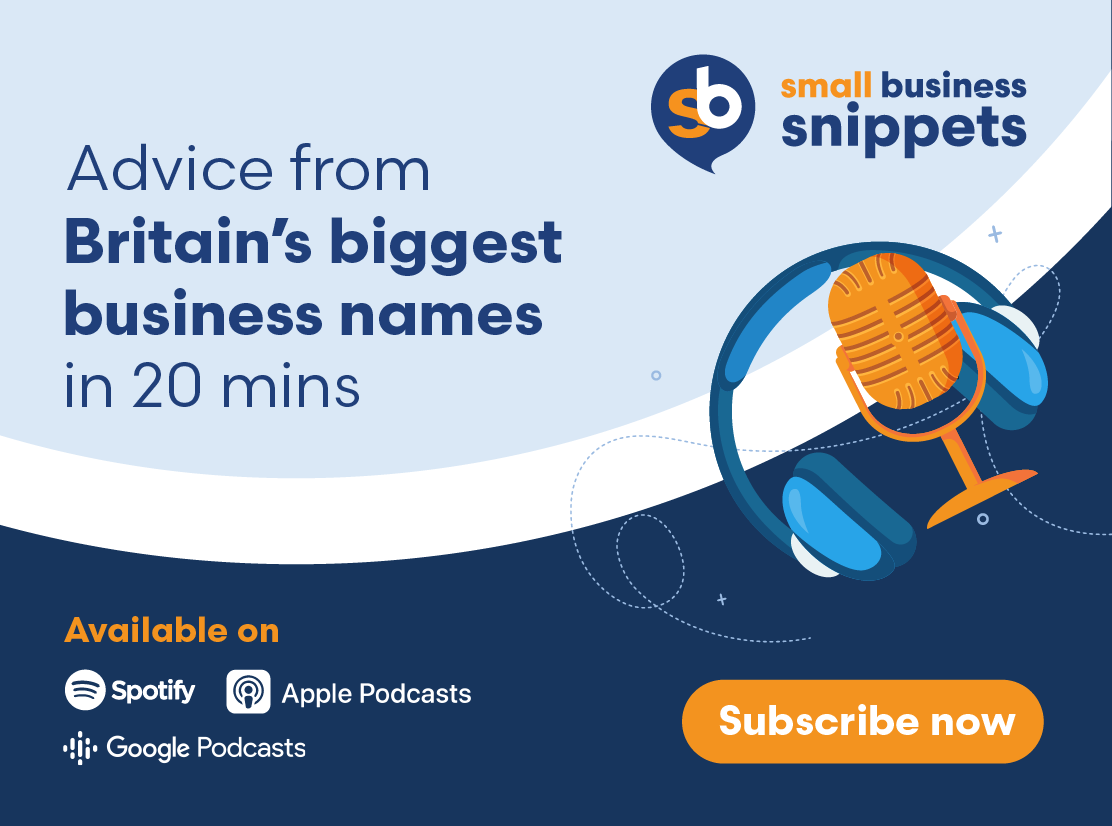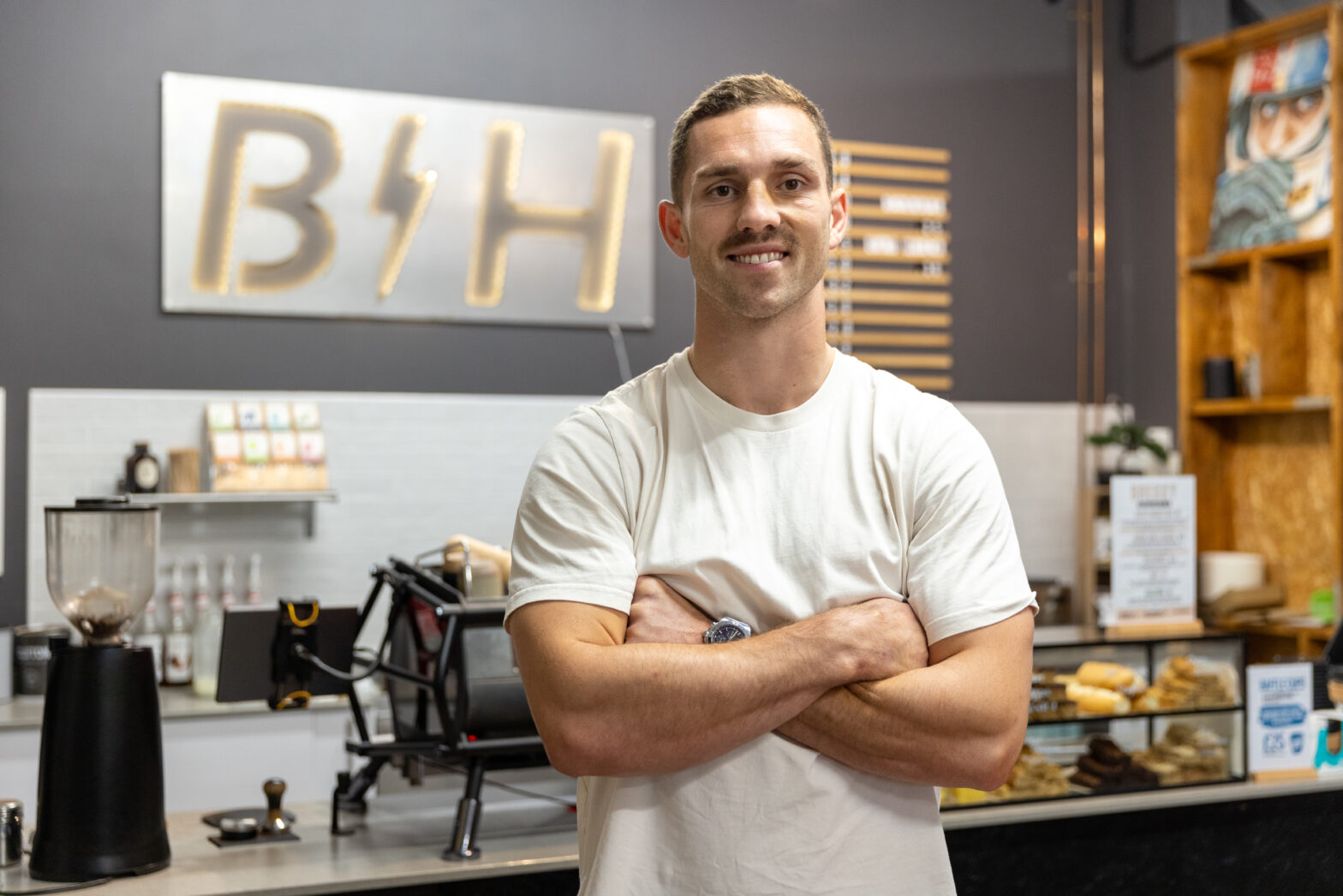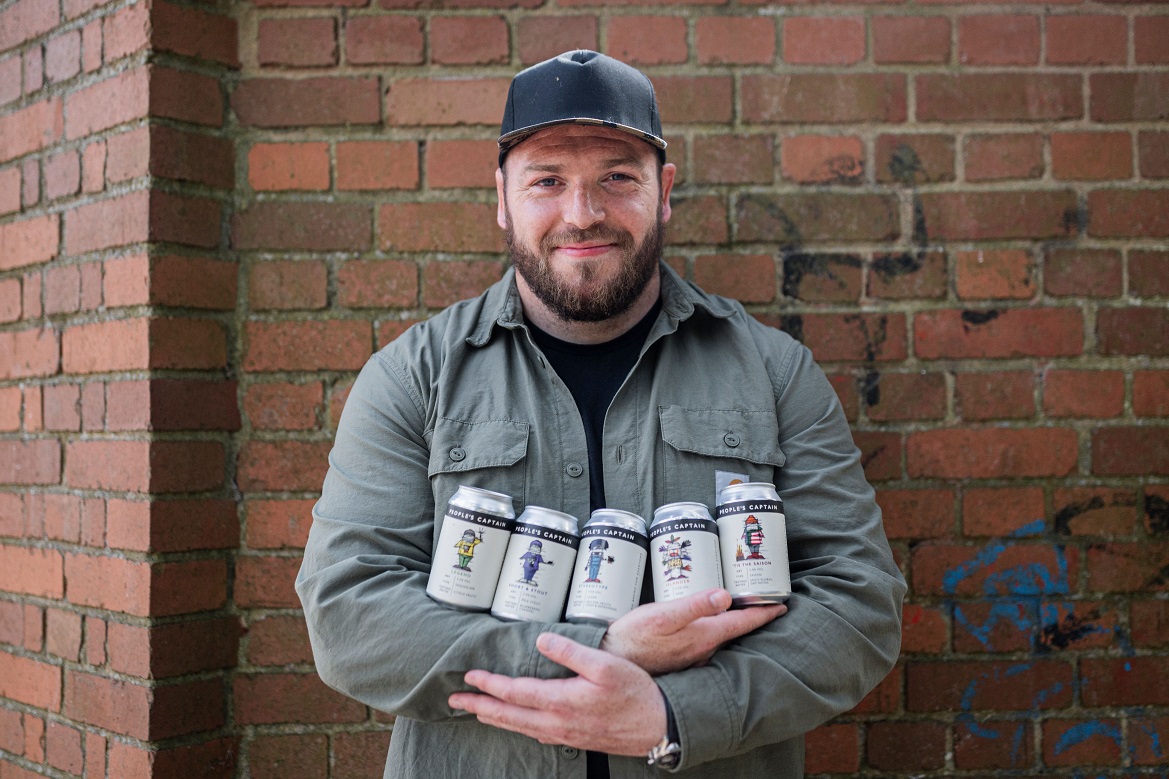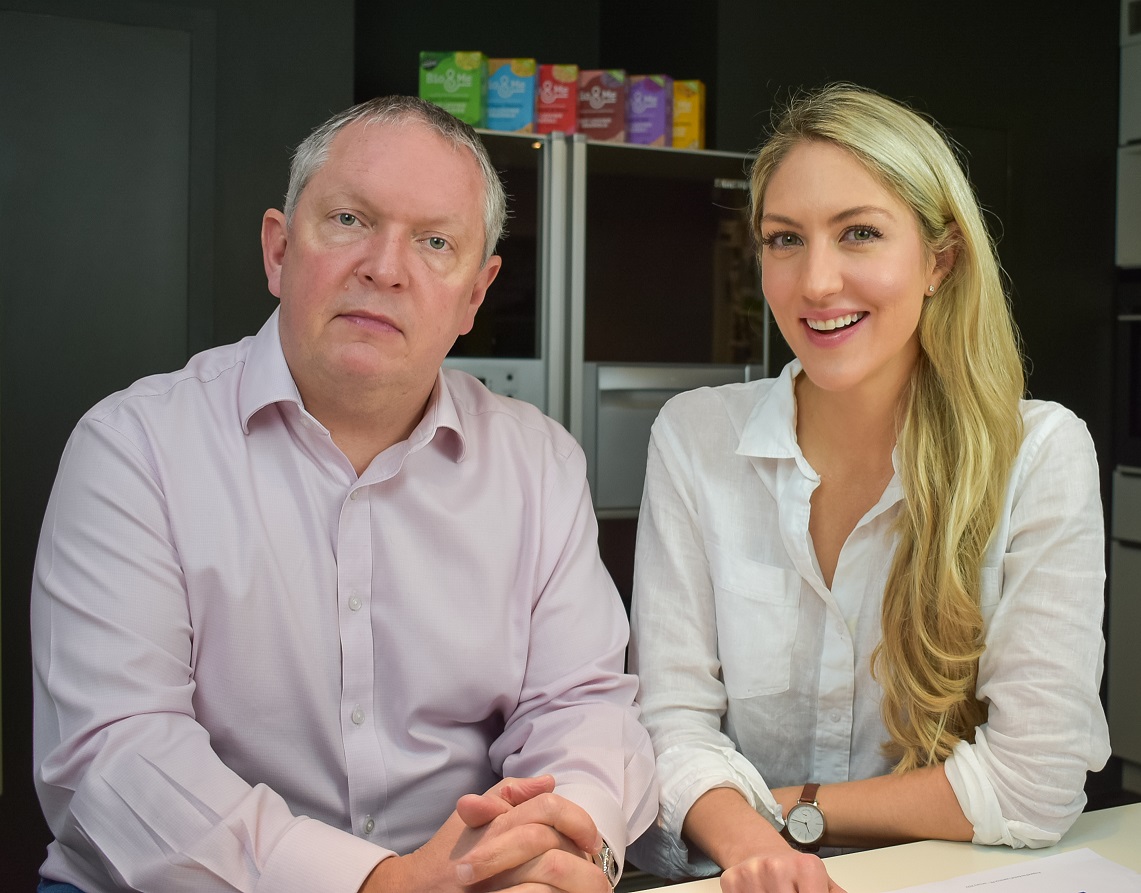Welcome to Small Business Snippets, the podcast from SmallBusiness.co.uk. Today’s guest is Grace Beverley, entrepreneur, author, investor and podcaster.
We discuss productivity and taking part in sales events ethically.
Listen to it in the media player below.
Or watch a couple of teaser videos.
You can also catch our episodes with:
- Entrepreneur and star of SAS: Who Dares Wins, Ollie Ollerton
- Business owner and former pro footballer, Thomas Hal Robson-Kanu
- Myleene Klass and Jamie Barber, founders of My Supper Hero
- Pub owner and winner of The Great British Bake Off, Candice Brown
- Entrepreneur and former athlete, Sally Gunnell
- Entrepreneur and The Apprentice winner, Sian Gabbidon
- Abel & Cole founder and chairman of Freddie’s Flowers, Keith Abel
- Entrepreneur and The Apprentice 2019 winner, Carina Lepore
- Dragon Tej Lalvani and entrepreneur Sam Jones
- Angel investor, entrepreneur and TV personality, Spencer Matthews
- Entrepreneur and former Dragon on Dragon’s Den Ireland, Lady Chanelle McCoy
- Businessman and The Apprentice winner, Mark Wright
- Entrepreneur and campaigner, Paul Lindley
- Managing director of Brompton Bikes, Will Butler-Adams
- Businessman and author, Gerald Ratner
- Entrepreneur and TV presenter, Trinny Woodall
- Pub owner and bartender on Channel 4’s First Dates, Merlin Griffiths
- Founder and chairman of Pimlico (formerly Pimlico Plumbers), Charlie Mullins
- Retail expert and former Dragon, Theo Paphitis
- Author and boardroom expert, John Tusa
- Digital guru and investor, Sherry Coutu
- Entrepreneur and former Dragon, Rachel Elnaugh
- Businesswoman and Dragon, Deborah Meaden
- Entrepreneur and The Apprentice 2005 candidate, Tim Campbell
- Gousto CEO, Timo Boldt
- Entrepreneur and The Apprentice 2018 candidate, Jackie Fast
- Investor and former Dragon, Piers Linney
- Investment fund manager, Nicola Horlick
- Supermodel turned entrepreneur, Caprice
We’ve got podcast episodes from the first series looking at:
- How one business owner’s mental breakdown caused her to see trolls from her past
- How one entrepreneur hired a videographer to track their every move and build their business brand
- How funding a business led one entrepreneur to stress-related alopecia
- One entrepreneur’s first professional public speaking engagement
- Adapting to UK life and learning English before starting a business
- Securing seed funding
- Finding the perfect head of customer care
- Reaching a £1 million annual rate of return
- Boosting client numbers from 30 to 850
- Starting a brand new business from scratch
To find out more about Small Business Snippets, you can download the trailer.
If you want to listen to the podcast elsewhere, it’s available on Apple Podcasts, Google Podcasts and Spotify. Watch the new video versions and subscribe over at our YouTube channel. It’d also be great if you could leave us a review.
Remember to like us on Facebook @SmallBusinessExperts and follow us on Twitter @smallbusinessuk, all lower case.
Want to read Grace Beverley’s podcast interview instead?
Hello and welcome to Small Business Snippets, the podcast from SmallBusiness.co.uk. I’m your host, Anna Jordan.
Our guest today is Grace Beverley – entrepreneur, author of the Sunday Times bestseller, Working Hard, Hardly Working, and host of a podcast of the same name.
Grace is the founder and CEO of two businesses, TALA and Shreddy. Fitness app Shreddy launched in 2016, followed by her sustainably made activewear brand, TALA, in 2019. In 2020, Grace was named first on the Forbes 30 under 30’s retail and e-commerce list at the age of 23. The entrepreneur landed a £4.2m investment for TALA earlier this year and is also an investor in Wild Deodorant, Clean Kitchen, Drink Nice and Your Heights.
We’ll be talking about productivity and the challenges Grace has come up against in raising funding.
Anna: Hi, Grace, how are you?
Grace: Good, thank you. How are you?
Anna: Yeah, not bad. Not bad at all.
So today is the first day of Black Friday. So it’s November 25. It’s a huge day for retail, but also a problematic day for some. If you’re coming at it from an ethical and sustainability standpoint, it can be difficult. On your companies, you have Black Friday pledges.
How can small businesses stay involved in Black Friday and big selling events throughout the year without compromising their ethical and sustainability standards?
Grace: I think there really is no one size fits all approach. Of course, it’s different to every business. And when it comes to sustainability, especially with any area that kind of talks about consumption, obviously, it’s not black and white at all. As much as, for one business, what’s more sustainable might be less so for another business. I think that’s really, really important to bear in mind that, if you’re running a small business, and it’s a really important time of year for you, especially coming up to gifting season and you’re competing against much bigger companies, I think what’s really important is not shaming smaller businesses and more sustainable businesses for getting involved in that.
Now, with that being said, I think it’s very important define the parameters in which you are going to get involved in something like Black Friday. What we do at TALA and Shreddy, we created a Black Friday pledge. So that was essentially saying what we are going to do and what we’re not going to do. That allows the transparency for a consumer to then be able to say, ‘Yes, I am going to buy’ or, ‘No, I’m not going to buy.’
I think when you shame sustainable businesses out of participating in any discounting time, it’s very, very difficult, then, to create a landscape where sustainable business can play any part in changing these industries. When you look at fashion, of course, sustainable fashion is always going to be an oxymoron, it’s always going to be contradictory. But at the same time, in order for the mass market and the mainstream to be better, there needs to be options for companies who produce more ethically and more sustainably, even if that’s not perfect, because sustainable fashion will never be perfect.
I think one of the most important things, and it’ll be different for every business, is to really establish what makes you feel comfortable as a business, what furthers your mission. I think anything that compromises a mission definitely isn’t the right thing to be doing. For example, at TALA our aim is to disrupt the activewear mass market. We want people who usually shop mass market activewear brands to start shopping better, start thinking about sustainability and ethics. We’re completely transparent about the ways that we do and don’t do that in order for people to be able to, I guess, facilitate just the conversation and talking about it and thinking about it a bit more. So, with that in mind, it furthers our mission to be able to offer 10-30 per cent discounts on Black Friday, dependent on the product. That is because we also completely understand that there are gifts to buy and leggings to replace and, in terms of making sustainability accessible, that needs to be a price point. Black Friday will be the only time where certain people can access certain products and therefore we do think that it is really important to create an offering around this time but be really clear about what that is and what that isn’t.
In the same breath, we need to make sure that we are educating on overconsumption. Education on things like panic buying and planning you’re buying, all of those things that can make you have a more sustainable Black Friday. I personally don’t believe that shaming people completely out of engaging in consumption as a whole, like buying gifts, is necessarily going to fix the whole market, I’d rather there be better options within the marketplace.
For those small businesses, I’d say, transparency around the way you engage, but also, small businesses are always going to be far more sustainable than larger businesses. If it’s an important time of year for you engage in it in the way you want to. Just be clear about why you’re doing that and what you are and are not doing.
Could you give us an example of what some of our educational messaging might look like?
Grace: Yeah, sure. I mean, anyone can go to the TALA pages to have a little look at what that might look like. We make sure, at the beginning of any sale period, to put a blog post out that goes into detail about why we what we do participate in and what we don’t participate in, about the risks of overconsumption, about all of these kinds of various different things. And I think that when you’re involved in that industry, it’s really easy to assume that everyone has that background of actually understanding the different industries and that way.
I think that the majority of the time, when I tell some of my friends, for example, the horrors of some of the fast fashion things, they’re kind of like, ‘Oh, my God, what?’ I think when you’re very much in that space, it’s easy to assume that everyone knows that and chooses to ignore that. We try to just make sure that, for example, before the sale goes live, we release something saying, ‘This is everything that’s in the sale’, so that people don’t panic and buy within that moment. We share long-form writing (especially from our sustainability manager) on how to shop better, but also some things you probably didn’t know about Black Friday, etc, etc.
Anything educational, both to help the consumer in their individual shopping experience around Black Friday and around the holiday season. Just general education as a whole on the industry.
You’ve recently raised £4.2m for TALA. Congratulations. There are issues that we already know about for women business owners seeking investment, but possibly also young women, and possibly also somebody who was a former influencer.
What kind of challenges and issues that you experienced when trying to raise funding?
Grace: I would say that women raising capital is definitely the most important part of that to talk about.
When you look at the funding landscape, especially venture capital, but actually all forms of funding, women took 2.8 per cent on the highest year ever of venture capital funding. So that is 97.2 per cent of the entire industry going to male founders. I think that becomes particularly problematic when you think of the fact that everyone’s job is likely to be for a business and that business was going to have to be started from entrepreneurship. Now obviously, all of those weren’t taken funding in some way, but the majority of the big ones were and so that becomes really problematic when you think about it that way. There’s definitely something that I’m completely surprised that it’s never talked about on a like a wider scale. It seems like a niche part of a niche industry. But actually, it’s relevant to the large majority, that’s how all businesses are starting, then how do we get wider gender equality in terms of pay, in terms of every other area of the industry. So, I think that’s really, really important to talk about.
The statistics are stacked completely against women when it comes to funding – that gets far worse when you look at black women. I think the stat for that is 0.024 per cent of funding, which is just the most appalling statistic I think anyone can possibly imagine. The fact that that doesn’t hit the papers every day is completely surprising to me. If you looked in any other industry and 0.024 per cent, was like, ‘That is really, really appalling’.
I also went to Oxford, and we know that founders who went to Oxford or Ivy League are much more likely to get funding. And so there’s, of course, there are elements that would have held me back. I also think that, in part, the influencer way would have helped to kind of spur that forward in terms of being able to guarantee a certain amount of demand, but definitely didn’t make it as easy as certain contingents in terms of being able to kind of get that funding. I think that yeah, as I mentioned, the women getting funding is the most important part of that to talk about.
I was really lucky in our funding round that we raised. TALA was my second business that we were raise funding for, and we raised that 2.5 years post-revenue. We already were able to prove a certain amount of the business model working, and therefore there was less of having to take a ‘risk’. It’s still a risk, of course. Our next stage of growth is reliant on us being able to deliver that and increase that demand far beyond my existing audience.
As you can probably imagine, not having revenue and just betting on an idea, investors are far more likely to choose success stories that they know work, which is more likely to be, as you can expect, usually men in tech.
Obviously, there are a lot of things that do. We were really lucky to be raising 2.5 years post-revenue. We got six term sheets after six weeks of pitching for about nine hours a day. It was gruelling. But that was obviously incredibly exciting. There were definitely challenges along the way, I have no doubt that we probably walked into some rooms and some people thought, ‘Oh, this seems strange, a female founder and a female managing director. I wonder how on earth they can make money.’ But I’m lucky to be here, very excited about the business delivering on our targets and about to embark on the next stage of TALA.
How have your experiences shaped how you’ve invested in other businesses?
Grace: I mainly invest in businesses that I think I could help in some way. So, that’s usually businesses where I have some experience in the sector, whether that’s a young female demographic customer, whether that’s sustainability, whether that’s fitness, whatever that might be – those are generally the ones I have the most interest in, because I feel like I can help them. That might be their digital marketing strategy, that might be their organic marketing strategy – a lot of these kind of various different things – those are what I generally try to invest in.
But of course, as you’ve mentioned, I do try to invest in women as much as possible. I think that is one of the most important ways for us to be able to start to reallocate those funds. I guess, though, when you look at the gender funding gap, you can probably only imagine the gender wealth gap. he The onus cannot just be placed on women to be funding more women. Of course, it’s part of my strategy. But ultimately, it needs to be a change that happens. People in very different situations from me, and funds to be able to really change that industry.
Anna: Oh, yeah. 100 per cent. A lot of change needs to come from the structure of boards and panels as well.
Grace: Absolutely, and women on investment committees as well within those. I think we saw with industries like beauty through the whole pandemic, you’re shutting down a multibillion-dollar industry for longer than you’re shutting down any other industry purely because actually the people in the decision-making rooms probably don’t value that industry. It seems so superficial. It seems like ‘Well, do you really need to be getting your nails done?’ At the same time, pretty much every other industry was open.
Just looking at the kind of decision-making processes and that probably if you don’t have people in the room who use the services, you’re also going to be missing out on huge opportunities. Because if in that investment committee room there aren’t women there who have problems to be solved by great new businesses, huge opportunities are going to be missed.
Totally, 100 per cent. So, when you were putting together your pitch deck for the TALA raise, you said you ‘disappeared off the face of the earth’.
But of course, organisation is such a huge part of getting through a task like that. Talk to us a bit about your to-do table productivity method.
Grace: So this is my favourite thing, I could probably talk about it for the rest of my life. Essentially, this method is based off the fact that I very easily get overwhelmed. That’s probably because I take on too many things. I have an insatiable appetite for taking opportunities, which is great in some ways, really bad in other ways.
What I essentially realised was, I started doing this at university, I believe. I’d started my first business at this point and then I was also doing my university course alongside and, what has happened, is I’d have a 40-task-long to do list. Every time I was going to a new task I’d be trying to work out which was the next most important task and like, ‘Oh, but I have 15 minutes until my next tutorial, so which one can I do?’ You shouldn’t constantly be trying to find that next task.
What I decided to do instead was just split that to-do list up into tasks, quick ticks and projects. Quick ticks are things that take under five minutes; tasks are the things that take five to 30 minutes; and projects take 30 minutes plus. This enables you to be able to instinctively prioritise, but also time block, because you can probably do a load of quick ticks together or a few tasks together when you have a bit of time.
It essentially just means that everything is a lot easier, both in the moment, and when you’re actually planning out your time. Because, for example, it’s a particularly hectic time. This week, it’s coming to the busiest period in the retail year, which means that there’s a lot on at the same time. We are planning for January, which is a huge area in the fitness space. I’m having all of these approvals coming in that might be approving a marketing campaign for January. But there’s also something really urgent that needs to be done for this week. At the same time I went up to Manchester this week with Meta and have been doing some work with them on their Good Ideas Studio, which means that I was spending time with a few small businesses there, talking to them about their problems, how to resolve those, just getting to know people, getting to network.
All of these different things then come into your schedule. It’s really difficult to be able to block that all out, but also to have full visibility over your tasks. I find methods like that particularly important in terms of being able to actually decipher what you need to do next, how you can be most productive and stop getting yourself so overwhelmed because everything looks the same weighting. Actually, there are three really important tasks and 20 things that you can probably blitz out in half an hour.
Like you mentioned there, you’re a real proponent for time blocking. Asking for a friend – if you’ve got tendencies towards perfectionism, or not running in the allotted time, what tips do you have for getting past these kinds of obstacles?
Grace: So I think what’s really important is to try in part – and I know this is not very useful – but to try in part to see it less as something that you need to absolutely stick to and more like parameters or recommendations throughout your day. However, I would also say on top of that, if you continuously find yourself running through the blocks, you probably don’t know how much time tasks actually take you. I think that that’s something that I definitely struggled with.
One of the first things to do, to actually understand how much time tasks take you, is to start writing it down. Take a one-week or two-week period and just start writing down, say, composing an email. I think that takes me 10 minutes, but it actually takes me 25, or whatever it might be. There are all of these different things that you start to have a bit more understanding. Then you can use that as a manual for how long things will take. What I generally do as well is I add on probably about like a 30 per cent buffer, because I understand that I’m not great at being able to understand that. If I think something’s going to take me half an hour, it’s probably going to take me 40-45 minutes, and I just work that in.
You really do need to be setting yourself up for success rather than failure. Otherwise, it’s going to constantly feel like you’re not doing enough and you’re doing it incorrectly. But I think that’s one of the best things you could do is to start planning and buffers. Same goes if you’re in a job where things often come flying in that need approval within the next hour. Just actually making sure that every two hours, you have a 15-minute block that’s just set aside for urgent tasks. I share my schedule on my Instagram Story every day and what I usually have during that is I have, essentially, allotments for the time that urgent tasks, when it’s going to come flying in, I’m going to need to be able to deal with them.
As an entrepreneur, and I’m sure a lot of our listeners would agree, they thrive on being busy. How do you keep that in check?
Grace: I’d say I probably don’t keep it [in check]. In fact, I’d say probably that’s the most simple answer. But I really tried to and I try to – every time I get it wildly wrong, I try to really take some learnings out of that in order to be able to make sure I don’t run into that situation again. So, I think there’s a lot of importance of trusting your team and delegating. But then there’s also a lot of importance in starting to give yourself time to recharge and really recognising rest as a form of productivity. I think we see rest is opposite to productivity whereas actually, if you don’t have rest, you can’t have productivity. If you don’t have productivity, you probably can’t have rest, especially if you’re the type of person who has like that entrepreneurial mindset.
So, I think that one of the most important things is there is a temptation to say yes to everything. But obviously, the key is to prioritise things which you feel most passionate about. So, at the moment, for example, this past week, I’ve been doing the Meta Good Ideas Studio, that’s something I’m really passionate about. I’ve really enjoyed meeting the small businesses.
It’s just, I think, it’s really important to prioritise those things that really hit right on your passions, because I feel like you’re going to spend a lot of the time, especially as an entrepreneur, doing things that you don’t want to do. It’s a very natural part of the business. There’s so much admin, there’s so much logistics and you pretty much have to be a jack of all trades. You’re probably only good at about half of those things. I feel like it is really important to, even if something’s extra, those things that are things that you’re really passionate about, like I’ve been doing on that extra project. It’s something that’s been super busy at the moment in the busiest time of the year. But actually, that’s the type of thing I really want to do. It recharges me in a different way, if that makes sense.
Then on top of that, obviously one of the biggest things has been making sure that, over time, and especially over this year, how TALA’s doubled its headcount now, which is fantastic, but it also means lots of new people. In order for that to work, there needs to be a lot of time spent building up people’s confidence, building up systems to make sure that the teams work best with each other.
Allowing that kind of time and space to understand that, actually, pretty much a whole brand team has started within the past three months, and therefore I’m not going to be able to delegate everything at this time. Or I’m going to have to spend a lot more time in work than I probably would the rest of year.
I guess those are the driving factors and the rules I have around busyness. Do the things that you’re really passionate about and make space for those because that is a different type of recharge. Especially if you’re usually in the nitty gritty of the business, and then also get really good at delegating, but understand that it’s not always going to be possible to delegate. Sometimes you just have to factor in that time to spend a little bit more time with people, especially if they’re new.
I think we always have this expectation that we’re going to be able to hit the ground running on everything and it’s just so not the case. So, giving yourself that kind of grace and time in order to be able to adapt, I think that’s incredibly important.
Anna: Well, that’s it from me. Thank you so much for coming on the podcast, Grace. It’s been great. That’s hard to say!
Grace: Thank you so much. It’s been lovely to chat to you.
You can find out more about Grace at Instagram.com/gracebeverley. You can also visit smallbusiness.co.uk for more on productivity. Remember to like us on Facebook @SmallBusinessExperts, follow us on Twitter @smallbusinessuk (all lowercase) and subscribe to our YouTube channel, linked in the description. Until next time, thank you for listening.





